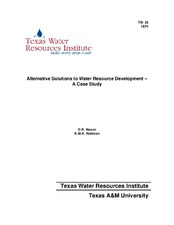| dc.description.abstract | This study was undertaken in an effort to develop procedural methodology for the consideration of alternative solutions for water resources development in a short period of time with a view toward reduction of total costs involved in prefeasibility studies. A review of related literature was made to reveal the status of the need for the development of a comprehensive method to evaluate possible alternatives.
Three techniques were developed in this research effort to estimate the investment costs of a reservoir project, a levee project, and a basin conservation reservoir project in an economic region. The application of the methodologies were illustrated by a case study. The cost of a reservoir project in the case study area determined by the method developed in this investigation was in excellent agreement with the Corps of Engineers' estimate using conventional methods. In general, the dependability of all the three methodologies were considered good for use in order-ofmagnitude estimates.
Selected solutions for water resources development problems in the Navasota River watershed were analyzed. The cost of water supply by desalination in the service area of the proposed Millican reservoir was computed following the procedure recommended by the Office of Saline Water. The investment costs of the alternatives were compared. The multipurpose reservoir project for flood control, water supply and recreation was found to be the least costly project. However, levees for flood protection in the lower Brazos River basin and desalting for water supply appeared to possess more intangible environmental benefits although the estimated cost of this multipurpose alternative was somewhat higher in comparison to the multipurpose reservoir project.
Evaluation of intangible cost factors (environmental, aesthetic, etc.) was not possible in want of scientifically amenable procedures. Total costs (combined tangible and intangible factors) of all alternative plans could not be estimated. As a result, no attempt was made to recommend any specific alternative to the proposed action in the case study area. | en |


